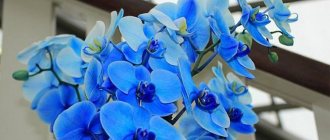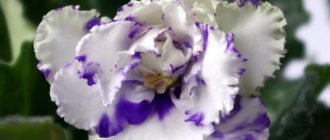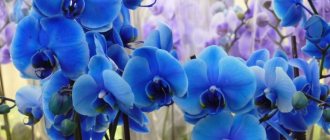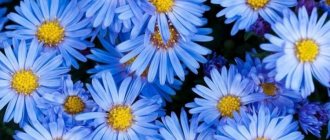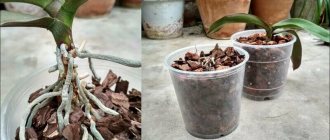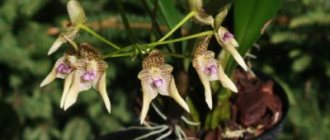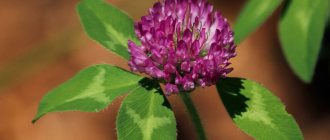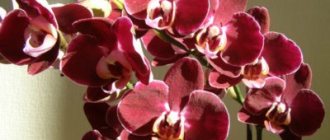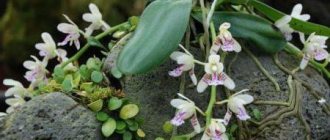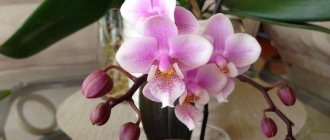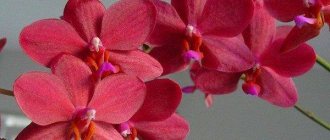The blue orchid is a rare and very attractive flower. The plant is found in India, Thailand, and Southern China. The flowers have a diameter of 9 centimeters. The shades of the petals are varied - from blue to red-violet.
An orchid can also turn blue when the petals are stained with chemical dyes or as a result of the dye being introduced into the stem. But such flowers cannot be called real. In nature, a prominent representative of blue orchids is the Vanda variety. Cattleya should also be noted. And Phalaenopsis is painted - this species does not have blue flowers.
Looking for the blue orchid
Features of the Vanda variety
The royal flower looks attractive, and its care should be appropriate. If you do not have knowledge of growing the plant, Wanda is unlikely to take root. The flower has many hybrids that are convenient to cross.
Is Phalaenopsis blue?
Blue specimens of the Phalaenopsis species are not found. But you can buy a blue flower, which is easy to care for. In the photo the plant looks very attractive, the smell is weak, not spicy. Phalaenopsis blooms for six months; the color of the petals may vary.
Features of the Cattleya orchid
Cattleya receives only positive reviews, as it is not too capricious, it does not require special care, and the plant looks charming. At home it blooms well, the palette of petal shades is varied.
Pletnev was a witness in the Blue Orchid case
Many Russian men know the pedophile Vladimir Timofeev from Novokuybyshevsk: he has been convicted four times for indecent acts with minors. He has been known to law enforcement agencies since the early 90s.
“Well, who doesn’t know Timokha,” our sources in law enforcement agencies were surprised, “this has now spread to adult boys.”
He has since been released after being convicted in 2007 of sexually assaulting two boys in a basement. But before, he was seriously interested in shooting photos and videos in the “nude” style. The models are underage boys; customers and buyers are from Moscow. They also provided the experienced operator with the funds to purchase professional video equipment.
He once got away with a lot. In 2000, Timofeev was detained for organizing a home porn studio and the Blue Orchid website. It was a pedophile server on which they exchanged videos and agreed to exchange child actors.
Detectives identified Timofeev’s accomplices in Moscow and the Moscow region. Four adult pedophiles were involved in the case. Their gang lured street boys from train stations, made films and forwarded videos to Timofeev.
Among those detained in Moscow, 42-year-old pedophile Sergei Prokopyuk deserves special attention. On his home computer, investigators found a video of Timofeev next to naked children.
When the prosecutor’s office employees began to “prick” Prokopyuk, he began to name the names of his clients to whom he sold the prohibited video. Among the names named within the walls of the prosecutor's office was the name of the conductor of the Russian National Orchestra, Mikhail Pletnev.
Subsequently, Pletnev was involved in a criminal case as a witness. Defenders of sexual minorities spoke out in support of Timofeev and Prokopyuk. While the police were giving sad press conferences, stars and politicians stood up to defend pedophiles (or important witnesses - buyers of child porn). Among the signatories were Valery Leontiev, Alla Pugacheva and Vladimir Zhirinovsky.
While the investigation was ongoing, the victims grew up and became adults. Many simply refused to make claims.
In the Blue Orchid case, Prokopyuk and four other pedophiles were nevertheless jailed; three more Russians and eight foreigners were arrested in Italy. But Timofeev managed to delay his new term for a short time.
Care depending on window location
- East window. In order for a blue plant to feel good on an eastern window, it should be placed in this place in the summer - from May to September. In winter, it is better to move the orchid to the south side. If you decide to leave the flower on the east window, in winter you need to provide it with additional lighting.
- North window. The blue snow leopard orchid and other types of the blue palette, located on the northern window, will not grow without artificial lighting, since partial shade is observed here all year round. It is lighting that has a direct impact on how the plant develops.
- West window. Caring for a flower located on the west window is the easiest. It's sunny here, but not too much. Some lighting problems may arise in winter, but most often there is enough light.
- South window. Royal Phalaenopsis feels good on a south-facing window, but since the plant placed here is always in the active growth stage, it may get sick. Sometimes burns may occur on the leaves, so it is recommended to place the plant behind a curtain.
Basic cultivation methods
When growing at home, it is important to choose the right container and substrate for the orchid. It must be remembered that the plant appreciates free breathing.
According to reviews, the flower whose roots were not damaged during transportation has a better chance of taking root. Even if the humidity in the room is low, if everything is normal with the roots, the plant will not die.
Improper care in the form of too frequent watering can cause rotting of the roots and stem. According to statistics, this error is the most common reason why orchids die at home.
There are different ways to grow a flower:
- You can plant an orchid in a pot or coconut.
- If there is no pot, you can place the flower in a black plastic basket, while the roots of the plant will hang freely. The presented method is suitable for growing in an apartment; it is often practiced in greenhouses and conservatories.
- It happens that an orchid is planted in baskets made of twigs, slats, bamboo sticks, or in flowerpots.
- You can place the plant on a block and decorate the roots.
- It is allowed to place the flower in a regular glass vase.
Important Details
Sometimes the question arises, how to paint an orchid blue? The plant is first assessed in terms of survival because this procedure places a lot of stress on the plant. Coloring is done with chemical ink, which is injected into the peduncle with a syringe.
They can also be painted by injection into the growing point, but this can lead to the death of the entire flower. After the procedure, the owner of the flower will receive a blue orchid, but not forever, but only until the end of this flowering phase. Unfortunately, a painted orchid may lose its flowers and roots and will have to be rescued.
Important. Instead of home dyeing, it is better to choose the Royal Blue variety, because this hybrid is dyed using a safe method.
How to deal with temperature
The orchid will look like the picture if it is provided with the correct temperature conditions. It should be chosen depending on the type of hybrid. The optimal regime for keeping the flower is +14 degrees at night, +25 degrees during the day. However, even in 40-degree heat the plant will not die.
Spraying
The orchid should be watered and sprayed, since it is grown mainly without a substrate. The outer parts of the plant, its roots, should be sprayed. The procedure should be actively carried out in the summer, when the air in the room is quite dry.
In winter, plants are sprayed once every couple of days. Moisture should only reach the roots. When liquid gets on the leaves and cores, these parts of the plant begin to rot and the leaves fall off. Rotting of the core leads to the death of the plant.
After each spraying, wipe the orchid with napkins. Instead of spraying, you can water the flowers in the shower. The water temperature should be about 40 degrees.
Features of care during the rest period
In fact, blue orchids only experience dormant periods when optimal conditions are created. First of all, this concerns lighting. How do you know if a plant has enough light? The easiest way is to look at the roots. If there is enough light, the roots will be in a state of active growth, and the flower will look bright and healthy.
If there is not enough light, the color of the leaves will not be as bright, and the tips of the roots will begin to shrink or become covered with white skin. This is how the orchid tells you that it has entered a period of rest and its metabolism has slowed down.
What to do in this case? If you notice that the flower begins to enter a sleepy state, provide it with artificial lighting in the evening from 18 to 22 hours. Such lighting will prevent the plant from “falling asleep” and reduce the risk of infections.
Are there blue or blue orchids?
Amateur flower growers should know that in the wild world only Vandas and Cattleyas bloom with buds of this color. Connoisseurs of phalaenopsis should accept the disappointing truth: only painted orchids are on the Russian market. These specimens will produce snow-white buds upon subsequent flowering.
The history of blue orchids
The first time flower growers were presented with orchids of an unusual blue color was in 2011; everyone could visit an exhibition with tropical plants in Florida. The first miracle flowers were presented by employees.
Successes of Japanese breeders
In 2013, after hard work, Japanese scientists managed to develop a blue phalaenopsis orchid by crossing several varieties: Aphrodite and Asian Camelina. After all, it is so inherent in nature that at the genetic level, phalaenopsis cannot produce blue pigment. The new orchid variety is called Royal Blue. Its flowering is abundant and lush, but the flowers themselves are small, no more than 5 centimeters in diameter. Such orchids have not yet been released for free sale; they are still shown at exhibitions for fabulous money.
What's the secret
Blue phalaenopsis, available on store shelves, have one secret: the plants are simply painted with paint in some part of them using the injection method. This means that next time the orchids will bloom with regular white flowers if they are not tinted in advance.
Do they exist in nature?
If you look hard enough, you can find orchids in the wild that have a shade close to blue or blue. They can be grayish, light azure or off-white.
Vanda Orchid: care features (video)
Caring for an orchid, no matter whether its petals are blue or not, should be carried out according to standard rules - timely spraying, sufficient lighting and optimal temperature. Blue flowers are quite rare, but if you want to get a specimen with an unusual shade of petals, you can choose blue varieties.
